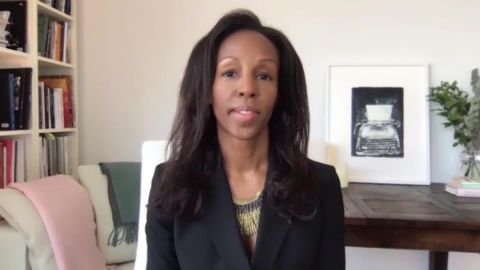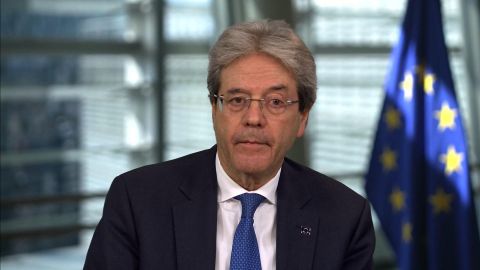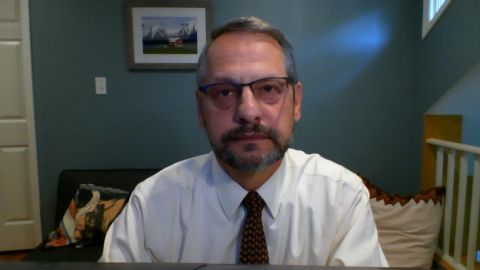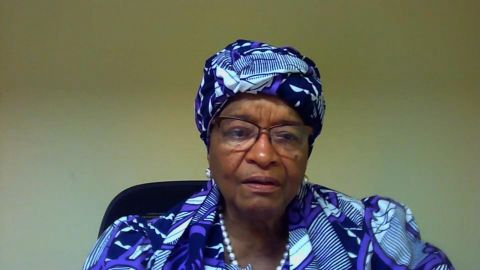Read Transcript EXPAND
CHRISTIANE AMANPOUR: And it`s often said that a picture in many of these crises is worth 1,000 words. But, during this pandemic, many of the images of those suffering and dying, of course, are behind closed doors, in hospitals and in care homes. And, instead, our screens have been saturated by statistics and press briefings, important, of course, to keep us informed. But our next guest says that we need to see the victims to better understand and connect with the human impact of this devastating virus. Sarah Lewis is an associate professor at Harvard, and she is discussing the vital role of artists and photographers during a crisis with our Walter Isaacson.
(BEGIN VIDEOTAPE)
WALTER ISAACSON: Thanks, Christiane. And thanks, Sarah Lewis, for joining us.
SARAH LEWIS, HARVARD UNIVERSITY ASSOCIATE PROFESSOR: Thank you for having me. It`s a pleasure.
ISAACSON: You have always written about and talked about the importance of pictures, of visuals to make us understand a situation. Why do we not have good visuals, good pictures of this coronavirus crisis?
LEWIS: This is a live question, and it`s an urgent one. It`s one I asked myself when I began to not see the images of mass devastation that globally we`re experiencing for the last few months. It became more important to me to consider the question when many of my loved ones and colleagues began to die. So, I began to think back over time about when in history we have seen images that have moved us to act in moments of injustice and crisis, of the kind which we`re experiencing now.
ISAACSON: The beginning of that probably was Mathew Brady in the Civil War, right?
LEWIS: Yes, Mathew Brady was one of the incredible photographers, Alexander Gardner and others included, who documented the Civil War. And it gave people a sense, more so than statistics alone, of what we were actually coping with. I was talking with an incredible historian, Drew Faust, former president of Harvard and my colleague, and she reminded me of something I had forgotten in reading about the Civil War, which is that the term realized was used in the literal sense. Photographs gave people a sense of what was real in front of them. We know the death toll count for the Civil War now was 700,000 souls lost. And that`s difficult for the mind to comprehend. So, pictures gave people a sense of that when they went on view and his gallery in downtown New York, in his Broadway gallery.
ISAACSON: We had those visuals very much in the Vietnam War. And it changed our sense of that war. Did something happened after Vietnam, where we changed our social norms, and we don`t use pictures of the dead as much?
LEWIS: It`s a great point. Absolutely. So, images galvanized the opposition to the war during the Vietnam War. And the question then became political. How are we going to use images in our media and in politics? So what changed was, after the Persian Gulf War, during the H.W. Bush administration, there was a shift in terms of the policy regarding images of the dead. So, you began to not have images circulate for the subsequent 19 years, until 2009, when, under the Obama administration, there was a change in policy. And so we then finally saw images of the sacrifice and the cost of our crises around the world. And so the question that you asked me at the start, why are we not seeing images of the pandemic, in terms of human cost, is really a cultural one. It`s a matter of the shifts that have happened over time.
ISAACSON: And we see pictures of the pandemic, but it`s either the president in the Rose Garden or some visualization of a spiky coronavirus ball or maybe a health care worker.
LEWIS: Yes.
ISAACSON: Are there visuals of the true suffering, and they`re just not being spread around? Or what`s the problem?
LEWIS: There are many ways to consider it. I would just outline three. First, American medical privacy laws do respect the dignity of suffering and dying. And that`s a good thing. So, HIPAA laws do prevent us from having a sense of the cost. On the other hand, there are ways around us this that other countries have found that are effective, in terms of giving people a sense of what`s really at stake. So, there are questions about that. And it`s — I`m not in the medical field, but what I do know historically is that there have been moments in which we have been allowed to see the human cost of a political act, or, in this case, of a pandemic. And it`s been important and effective. I think the other reason that we`re not seeing this, in part, is because we`re — we haven`t figured out or calibrated what our cultural norm is going to be around images of death. We don`t talk about death very much as a culture. And there are many reasons for that. But photography is one of the moments in which we`re able to rally around how it is we want to honor human lives. Mathew Brady is one example of how we have done this. There are many other examples.
ISAACSON: One of the other examples was down here in Hurricane Katrina, where we suddenly got galvanized as a nation with the absolutely shocking photographs of the people who had been killed.
LEWIS: Yes. So, we see these moments in which we cannot comprehend the gravitas of a moment without pictures, without images. And Hurricane Katrina is one incredible example. There are many others. If you think about this going even farther back in time, think about the Great Depression, right? The Farm Security Administration is an example of how the government marshaled the power of photographs to give people a sense of the catastrophes that were being experienced, especially in rural communities. And then you can fast-forward up to the current day. We have instances of racial terror, which are galvanizing people to finally have a greater sense of accountability and to act. There are many examples.
ISAACSON: During the Depression, it was the federal government who wanted to document it. And didn`t Walker Evans, wasn`t he one of the great photographers who did that and helped change our sense of the policies?
LEWIS: He did. So, FDR`s New Deal inaugurated the sense that photographs could give people a sense of what was possible after devastation. So, Walker Evans was one of the many, along with Gordon Parks and Dorothea Lange, who were commissioned by Roy Stryker, who led this organization that we call the FSA, the Farm Security Administration. And some of our most iconic photographs have come from that effort. So, Dorothea Lange`s Migrant Mother is an extraordinary example of that, 1935 photographs, where she was showing us a family, a mother in a moment of crisis. There`s a pea picking village that`s north of Los Angeles, about 175 miles north, that`s — in which there`s just starvation that`s rampant. So, Dorothea Lange at the time was actually on a temporary basis hired, working with her — man who would ultimately become her husband, Paul Taylor, in order to illuminate the suffering. And she brought this print that was almost — it was barely dry to the San Francisco News Agency, and they called immediately back a relief agency, were able to airlift food to that area in California. And then, subsequently, the image was published by the United Press. So it gives you a sense of the way in which images actually can galvanize the public and can activate and catalyze policy too.
ISAACSON: One of the iconic photographs we do have is of that mass burial on Hart Island and the trenches being dug. I think it was taken using a drone. Tell me the backstory there.
LEWIS: So that`s an extraordinary photograph. George Steinmetz attempted to document the mass burials that are happening on Hart Island, and very few people know what`s happening there. It`s largely a place where you are interred or buried if you don`t have the private funds for a burial or next of kin doesn`t claim you. And many who died of COVID are being buried there. So, George Steinmetz, in an act of, I would say, real vision and bravery, was attempting to show us the human cost of COVID. Now, his drone was intercepted, and he was only able to take three photographs. You have to have a permit from the Department of Corrections in order to do this. And so he wasn`t able to really capture, I think, the full scope of what he had intended. But it`s an example of the impulse that artists have, that photojournalists have to give us a real sense of the gravitas of the moment.
ISAACSON: One image that actually had an impact, because it affected the president of the United States, was the photograph of freezer trucks being brought into the borough of Queens. And it actually caused Trump to reevaluate some of his thinking for a little while, right?
LEWIS: It did. It did. This is really one of the central questions in terms of the history of photography. How can images inspire empathy? When do they and when do they not? So, Trump is an example here of offering as a sense of being moved to act. And this is, of course, a president who was eager to reopen the country by Easter prior to that moment of seeing images of the dead in his hometown in Queens, New York, or close to it, as he said.
ISAACSON: The last time we had a viral crisis, it was very well- documented, which was HIV/AIDS. Compare and contrast what happened during that epidemic and now in terms of visuals.
LEWIS: That`s a fascinating compare-and-contrast example, because I think there`s some differences here that put an even greater onus on the power of the arts. I think, in the HIV/AIDS pandemic, we were dealing with stigma surrounding the gay community at the time. And the question then became, well, how do you humanize those who are suffering, who are suffering also in the face of government inaction? So those images played a really crucial role. And they were artists, yes. There were also collectives, such as Gran Fury, doing some of this work. What you see with HIV/AIDS imagery is also the endurance of that effort, how long it took, how many years and decades it took to continue to document the crisis. And for us, I think the question about duration is different. We now have – – we have to act very quickly, and it`s affecting us in a global sense. And so the question then becomes, how can we marshal our artists to get these images out, yes, to politicians, it seems, if we`re going to use President Trump as the example, as we just mentioned, but really to all of us, so that we will honor the stay-at-home orders, that we will actually take seriously this crisis?
ISAACSON: In your book “The Rise,” you talk about how creative achievements sometimes arise from failure or challenges or things going wrong. How do you think the coronavirus will affect creative achievements?
LEWIS: Whew, what a question. During crises, artists do get to work. And this is what — it gives me a kind of silver lining of hope about the moment. And part of what animated that project was to consider the extraordinary achievements that have come from the improbable foundations of all kinds, and the arts in particular. So this moment is fertile for them. I think people dig into themselves during crises. They`re able to understand their own capacities. And if there is any, I would say, almost eternal truth about the arts, it`s that it forces this reckoning between who we are and who we think we are and who we actually could be.
ISAACSON: What would you urge photographers and visual artists to be doing now, as we go through this pandemic?
LEWIS: One of the main tasks that I hope artists consider is not what the answer to the crisis is, but what the right questions are for whatever new normal we emerge into. I think, often, we consider artists as those who point the way or who remind us of when we have fallen short of a particular goal. So, I think a way to get us to consider that is by asking these questions, regardless of the medium. Now, practically speaking, I know that there are restrictions on how it is that we move around. But that kind of deep probing is still possible from wherever it is that we sit.
ISAACSON: As we go through this pandemic, I think we`re reminded of how art is always connected to justice. Art helps pave the way for justice. Tell me how that plays into this current situation.
LEWIS: Yes. The crisis was making me think back to this extraordinary eulogy that President John F. Kennedy offered after Robert Frost died. And he said that, really, he was thinking about the function of the artist during a time of crisis. And he said that if our artists are most critical of our society, it is because of their sensitivity and their concern for justice that must motivate any true artist that makes him aware of when we fall short of our highest potential. I think that`s almost a direct quote. It`s an extraordinary line and I think an eternal truth about what the real quarrel, as James Baldwin might put it, the quarrel, the kind of lover`s war that an artist has with their society is actually about. So, today, if artists are finding themselves responding to the crisis, I would say it will probably be to quarrel with our society, to find ways in which we can reanimate and reconsider who it is that we really want to be as a society, as a country, as individuals. So this is really, I think, what the function of art is, in the end.
ISAACSON: We aren`t seeing many images of those most affected by COVID-19, people of color.
LEWIS: No.
ISAACSON: What long-term effect will that have?
LEWIS: Well, this is really — it`s a huge question. I mean, one of my colleagues, Evelynn Hammonds, the chair of history of science at Harvard, has an extraordinary “New York Times” piece about racial disparities in COVID. And one of the things it explains is that we are able to see the structural inequalities and also the implicit and explicit biases that we have always lived with in a more pronounced way. I would wish for myself, as an art historian, that we would have the images that would continue to underscore that reality and that fact, but we don`t fully. And I don`t know that we will. But the irony, of course, is that, if there was any silver lining of COVID that I personally had, it was that we wouldn`t have images of racial terror as much. But that`s been taken away with our — the images at least of Ahmaud Arbery and others. So, in terms of the lasting impact, I think it will force us to question how race intersects with our willingness to confront human suffering and cost. Are we more willing in some cases than others? This is still, I think, a question for scholars and historians.
ISAACSON: You mentioned the video of the fatal shooting of the jogger Ahmaud Arbery.
LEWIS: Yes.
ISAACSON: How does that fit into what you`re saying about race and justice and visual images?
LEWIS: So, the hyper-visibility of racial terror is really nothing new in American life. Scholar and cultural story and Jasmine Nichole Cobb is extraordinary on this point in her book “Picture Freedom.” She looks at the way in which the legacies of slavery in particular have given us this kind of ocularity to citizenship. It`s given us a culture of surveillance of black bodies. And, ultimately, what we`re seeing with the Ahmaud Arbery video is another example of that. It`s — it shows us this long history. But what`s changed, I think, is how it`s animating our discussion of how it is that images can spark a conversation about race and belonging and human — and honoring human life. So, what it`s allowed for is a kind of accountability. That image has led to accountability. It hasn`t necessarily led to justice. And — but what is happening is, I think, this robust conversation about images and race and justice, which we sorely need in our country.
ISAACSON: Sarah Lewis, thanks so much for joining us. Stay well.
LEWIS: Thank you. Thank you for having me, Walter.
About This Episode EXPAND
Christiane speaks with former Liberian president Ellen Johnson Sirleaf about the importance of international unity in fighting a virus. She also speaks with European Commissioner for Economy Paolo Gentiloni about whether Europe should open for the summer and Dr. Boris Lushniak, former U.S. Acting Surgeon General. Walter Isaacson speaks with Sarah Lewis about the power of photography.
LEARN MORE



